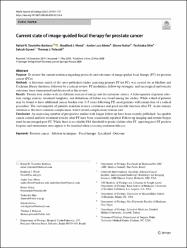| dc.contributor.author | Tourinho-Barbosa, Rafael Rocha | |
| dc.contributor.author | Wood, Bradford J. | |
| dc.contributor.author | Abreu, Andre Luis | |
| dc.contributor.author | Nahar, Bruno | |
| dc.contributor.author | Shin, Toshitaka | |
| dc.contributor.author | Güven, Selçuk | |
| dc.contributor.author | Polascik, Thomas J. | |
| dc.date.accessioned | 2021-04-06T11:05:15Z | |
| dc.date.available | 2021-04-06T11:05:15Z | |
| dc.date.issued | 2021 | en_US |
| dc.identifier.citation | Tourinho-Barbosa, R. R., Wood, B. J., Abreu, A. L., Nahar, B., Shin, T., Güven, S. ... Polascik, T. J. (2021). Current state of image-guided focal therapy for prostate cancer. World Journal of Urology, 39(3), 701-717. https://dx.doi.org/10.1007/s00345-020-03254-4 | en_US |
| dc.identifier.issn | 0724-4983 | |
| dc.identifier.issn | 1433-8726 | |
| dc.identifier.uri | https://dx.doi.org/10.1007/s00345-020-03254-4 | |
| dc.identifier.uri | https://hdl.handle.net/20.500.12511/6703 | |
| dc.description.abstract | Purpose To review the current evidence regarding protocols and outcomes of image-guided focal therapy (FT) for prostate cancer (PCa). Methods A literature search of the latest published studies assessing primary FT for PCa was carried out in Medline and Cochrane library databases followed by a critical review. FT modalities, follow-up strategies, and oncological and toxicity outcomes were summarized and discussed in this review. Results Twenty-four studies with six different sources of energy met the inclusion criteria. A heterogeneity of patient selection, energy sources, treatment templates, and definitions of failure was found among the studies. While a third of patients may be found to have additional cancer burden over 3-5 years following FT, most patients will remain free of a radical procedure. The vast majority of patients maintain urinary continence and good erectile function after FT. Acute urinary retention is the most common complication, whilst severe complications remain rare. Conclusion An increasing number of prospective studies with longer follow-up have been recently published. Acceptable cancer control and low treatment toxicity after FT have been consistently reported. Follow-up imaging and routine biopsy must be encouraged post-FT. While there is no reliable PSA threshold to predict failure after FT, reporting post-FT positive biopsies and retreatment rates appear to be standard when assessing treatment efficacy. | en_US |
| dc.language.iso | eng | en_US |
| dc.publisher | Springer | en_US |
| dc.rights | info:eu-repo/semantics/embargoedAccess | en_US |
| dc.subject | Prostate Cancer | en_US |
| dc.subject | Ablation Techniques | en_US |
| dc.subject | Focal Therapy | en_US |
| dc.subject | Localized | en_US |
| dc.subject | Outcome | en_US |
| dc.title | Current state of image-guided focal therapy for prostate cancer | en_US |
| dc.type | article | en_US |
| dc.relation.ispartof | World Journal of Urology | en_US |
| dc.department | İstanbul Medipol Üniversitesi, Tıp Fakültesi, Cerrahi Tıp Bilimleri Bölümü, Üroloji Ana Bilim Dalı | en_US |
| dc.authorid | 0000-0002-5009-8435 | en_US |
| dc.identifier.volume | 39 | en_US |
| dc.identifier.issue | 3 | en_US |
| dc.identifier.startpage | 701 | en_US |
| dc.identifier.endpage | 717 | en_US |
| dc.relation.publicationcategory | Makale - Uluslararası Hakemli Dergi - Kurum Öğretim Elemanı | en_US |
| dc.identifier.doi | 10.1007/s00345-020-03254-4 | en_US |
| dc.identifier.wosquality | Q1 | en_US |
| dc.identifier.scopusquality | Q1 | en_US |


















